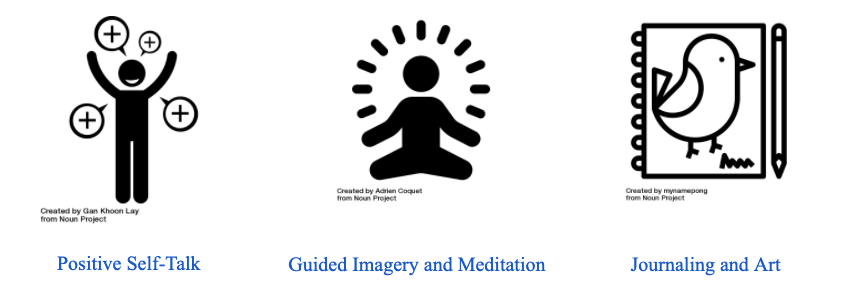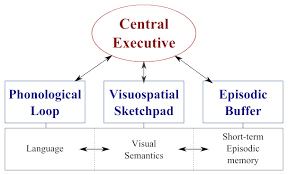PART III: Cognition and Coping
5
Coping with the Stressors of Middle School
Aja Perks; Charlie Huston; and Brooklyn Walker
The Link Between Wise Interventions
and Coping Mechanisms
The focus of this project is to provide information on how to cope with middle school stress in a healthy way, but before we can get into the details of our strategies, it’s important to introduce the concept ‘wise interventions’. They show how in small and even seemingly insignificant ways, you can change your whole outlook on your life situation and self concept.
What is a Wise Intervention?
Wise interventions, put simply, are interventions rooted in psychological theories aimed at helping people improve their daily lives and general wellbeing (Walton 73). In this particular context, when we use the word “wise”, we mean that the interventions made are intentionally sensitive practices (Walton & Wilson 618). These interventions aim to change contextual meanings which help people to flourish in their daily lives.

The goal should be to make an informed approach to dealing with social issues aimed at self improvement. Interventions are designed specifically to address a certain issue or problem and the approach must be precise and calculated in order to be properly effective.
The aim of a wise intervention is to examine the issue at hand that needs to be dealt with, then propose what needs to be fixed, and finally take action on what needs to be done. Once the problem is identified, it should be addressed in order to achieve social or personal change and betterment. “Wise interventions don’t address the objective qualities of either people or situations. Instead, they assume that subjective meaning making… can prevent people from taking advantage of opportunities for improvement already available to them” (Walton & Wilson 618). Overall, the intention is very similar to that of cognitive behavioral therapy.
According to Walton and Wilson, wise interventions should be characterized by five general principles. First, they alter specific meanings in order to promote a positive change. By “meanings” we refer to how people make sense of not only themselves, but others as well as the social situations people find themselves in. The second characteristic of wise interventions is that they should be able to operate in a variety of complex systems, not just a singular circumstance. Third, the new meanings developed should promote a particularly positive change in both people as well as situations. The fourth characteristic is that the new meanings should also be tested rigorously in order to ensure that they are effective and helpful instead of unintentionally causing harm or damage. Lastly, it is important that the wise interventions are analyzed carefully to make sure that the interventions taking place are indeed ethical.

In order to effectively intervene on our habits and meanings, it’s important that we are motivated by the right reasons; a need to understand oneself, circumstances and others around us, a driven need for self integrity, or a need to belong. Interventions can come from a variety of different places with the ultimate desired outcome being self and situational improvement. In our case specifically, we want to put an emphasis on a need to capitalize self integrity and a feeling of belonging, and we can practice self integrity improvement with the help of coping mechanisms to help get us there (Walton & Wilson 630).
Applying Wise Interventions to Coping Mechanisms
Direct labeling is one of the four broad categories of differing change strategies. It can be applied in a couple different settings: to the self, to other people, or to social situations as a whole. The idea is that providing a positive label for these aspects can change one’s thoughts and behaviors to become more in line with the label and therefore more beneficial.
However, the effect of direct labeling can “backfire if they imply that a personal quality is fixed, not an area in which people can grow,” (Walton & Wilson 624). For example, simply telling someone that they are intelligent can reinforce the idea that they have no control over how well they do in school, and can make it harder for them to overcome obstacles. This creates a ‘fixed mindset’, when in reality the goal is to adopt a ‘growth mindset’ and use direct labeling to improve in that area of your life, not convince yourself that you are stuck the way you are.
One way to use direct labeling is to change your self-identity. Using a positive label on yourself can help change the way you make sense of your identity. People tend to act in a way that reflects their self-concept, so when you change the way you understand yourself, you can also change your behavior.
You can also use direct labeling to change your beliefs about a certain goal or potential. It is much more likely that a person will pursue a goal if they believe they are capable of achieving it. In a teaching or mentoring position, leaders are more likely to invest more in other people if they believe they are capable as well. Therefore, direct labeling can be used to facilitate more positive beliefs in this setting.
In a similar way, it can also be used to bolster the sense of belonging even during hard times. Just changing the language on how sensitive matters are addressed or bad news is delivered can lead to feeling more supported and a more positive outcome.
Finally, direct labeling can be used to “change beliefs about social norms to motivate positive behaviors,” (Walton & Wilson 632). Labeling someone as part of a social group that goes against the norm, such as those who did not turn in an assignment on time, can provide more motivation to move out of that group and into the group of those who did. It can be used for the opposite effect as well.
Our Wise Intervention Logic Model
Within a Wise Intervention Logic model, there are negative situations, meanings, and behaviors that may allow for future benefits in one’s life if changed into positives. This creates a self-enhancing cycle. For middle school children, there are many stressors they may have to face so it is easy for them to develop unhealthy ways of coping. A negative situation in this case could be peer groups engaging in risky behaviors, like substance use. A young, impressionable teenager may think “well, everyone is doing it, so it must not be that bad” and develop meanings about the situation that further undermine the possible outcomes. As a result, the individual begins to participate in maladaptive behaviors, like using substances themselves, creating more and more negative situations.
It is a cycle that luckily has an opportunity to change. Altering one’s meaning and perspectives of a situation may help to change a behavior. For example, if an individual’s friend is negatively affected by the behavior, like having an accidental overdose, their thoughts and beliefs about the situation may change. Similarly, they could alter their view of risky behaviors by engaging in healthy ways of coping, making the behavior not as appealing as it once was. In turn, the behavior may be altered. One may see an improvement in the situation: peer groups not partaking in risky behaviors. The said individual may develop positive meanings and think “well, I do not need drugs because I can create art, write, and meditate”. Therefore, they begin incorporating only healthy coping skills into their lives.

The key to making an effective intervention is the ability to understand the mental mechanisms that underlie meaning making , that is, the process of cognition and how it relates to self concept and self regulation. With this knowledge and understanding, the targeted intervention is most likely to be effective and successful.
Introduction to Coping Mechanisms
Simply put, cognition is the array of mental processes our brain performs, including but not limited to perception, attention, working memory, long term memory, mental mapping, problem solving and so much more. Despite the idea of these mental processes occuring in our mind being very abstract, we analyze these processes with a critical lens in various ways. One way to understand cognition is to think of the information processing model. Our brain receives and analyzes information in a systematic way that is similar to computer programming, rather than simply responding to stimuli.
Coping mechanisms are strategies that people often use in the face of stress and/or traumatic experiences to help manage painful or difficult emotions. They can help people adjust to stressful events while helping them maintain their emotional well-being. Certain coping mechanisms may be more physically or psychologically harmful than helpful for an individual, so it is important that the knowledge of healthy coping strategies is readily accessible.

For children navigating the difficulties of growing up, they may be a bit too young to understand the importance of processing and dealing with stressors in a healthy way, so unhealthy coping methods may emerge. Through positive self-talk, guided imagery and meditation, and journaling and art as a form of expression, one may find it easier to deal with life’s constant curveballs. These coping mechanisms are effective because they influence the underlying cognitive mechanisms that give rise to desirable behaviors. That is, meditation can help improve executive functions such as attention, journaling and art helps with emotional stability and control, and positive self-talk is effective because it builds a more beneficial self-concept.

These coping mechanisms can be beneficial for anyone, but because they are simple, time conscious, and even fun, they can be especially helpful with children struggling with the hardships of growing up. Kids in middle school may be affected by personal development and identity concerns, peer group stress, family or parental tensions, hormones, self-esteem, and so much more. With having healthy strategies in one’s “toolbox”, it may be a bit easier to handle the twists and turns of junior high.
Cognitive psychology shows us that each of these coping mechanisms have roots in neuroscience. In understanding how to fully maximize these strategies, it’s important to consider the cognitive processes that give rise to them.
Cognition Basics
Cognition and mental processes are made possible by the firing of neurons which transmit information (Goldstein 27). As the nerve impulse transmits down the axon, it reaches the synapse, the small gap between the end of the axon and the dendrites of a of another neuron, where a chemical called a neurotransmitter is released during the action potential period (Goldstein 31).
The question of which neurons fire where can be answered by the idea of localization of function which tells us that specific functions are served by very specific areas in the brain (Goldstein 38). Each part of our brain serves a specific role to play in our cognitive processes. In order to clarify which part of the brain does what, we split the brain into four lobes: the frontal, parietal, occipital, and temporal. The frontal lobe is involved in action control and self regulation, the parietal lobe is involved in sensation perception, the occipital lobe controls vision, and the temporal lobe involves audition and semantics. They all serve different functions but work together. Within each lobe, various cortices are housed that carry out further specific actions. For example, the frontal lobe houses the prefrontal cortex which plays a major role in complex cognitive functions such as focus, attention, managing emotional reactions, impulse control, and it even plays a part in personality development.
Interestingly, there are actually two different kinds of processing our brain can do when it comes to perception, bottom up or top down. When we process from the bottom up, our environment is what stimulates the receptors and the processing moves up in the brain whereas top down processing starts in the brain and flows down into lower level functions and the senses.
As we perceive the world around us and live our daily lives, we are constantly using what are called the what and where pathways. These two pathways are what make it possible to perceive and take action. We call the “what” pathway the ventral stream and the “where” pathway the dorsal stream. The job of the ventral stream to carry out initial object identification while the dorsal stream determines the spatial location of the object being perceived. The two streams are independent of each other and therefore can operate at the same time, like looking at then picking up a cup of coffee, for example (Goldstein 83). Something quite remarkable that happens as we go about our lives is that our perception of things can change through experience dependent plasticity, or the shaping of neural responses through experience, in turn molding our nervous system (Goldstein 79).One way this could potentially be done is through practice of some of the aforementioned coping mechanisms. Through positive self-talk, guided imagery, meditation and journaling, one can practice taking control of the emotions or stressors being endured. That is, even though the ventral and dorsal streams operate without top-down control, we can create habits where we do control the flow of energy across the lobes.
Why Multiple Codes and Neural Pathways Matter
According to the principle of neural representation, everything that we experience is due not to the direct stimuli they come into contact with, but on how we represent such stimuli in our nervous system. There is no ‘one area’ for anything in particular; instead, the brain builds neural networks. These are behavioral patterns that result from habits among cells repeatedly firing together (Goldstein 32).
The brain has many ways of coding information. Specificity coding is not generally thought to be true, as there are too many objects in the world for it to be realistic that we have one specific neuron for each and every one of them. Population coding and sparse coding show the fraction of neurons that are activated by the information of either a large or small group of neurons (Goldstein 36).
This is important to remember in terms of learning because in order to master a skill successfully, it is ideal to build as many pathways “into”’ the brain as possible. Doing so increases the chances that you will encounter a stimulus that will activate the pathway, which in turn increases the likelihood that this certain set of neurons will fire together again, and that you will remember the information! This concept is known as encoding variability.
In terms of dealing with the stressors of middle school, this information can help to better memorize positive coping mechanisms. The more ways we encode the methods, the more likely it is that we will be able to retrieve them again from our brain’s database. Even in an emotional crisis! Here are all the different ways you can master the coping mechanisms:
1. Physically. For meditation or guided imagery, you can use breathing techniques to physically feel more calm and centered. An example of this would be to take a deep breath in for three seconds, hold it for three seconds, and then release it for three seconds, repeating the process as many times as you need. This will help you get into a peaceful mindset for meditation or guided imagery.
2. Mentally. This is fairly straightforward for meditation and guided imagery. Centering yourself in the here and now and doing your best to keep your mind ‘blank’ can help to ease tension. Guided imagery requires you to create detailed mental images to also ‘empty’ your mind and bring a sense of peace.
For positive self-talk, you can mentally repeat the empowering phrases in your mind. As you do so, it will make the impact even stronger if you visualize the positive sayings in your mind as well. For example, if the phrase is “I can succeed on this upcoming test,” as you say it, imagine yourself holding the test with an ‘A’ written on it, or something similar.
3. Verbally. With positive self-talk, you should say it out loud as well! Hearing these uplifting phrases out loud will help cement the positive impact. It will also help to make them feel more realistic.
4. Using Imagery. For drawing, turning your feelings into imagery can help to vent any frustration, and to gain some insight into your emotions. In journaling you can also incorporate “Sketchnoting” or icons within the words you write to help release the stress in a different way. Creating vivid scenes in your guided imagery help to increase your immersion in the experience and further clear your mind.
5. Emotionally. As expected, your emotions will be heavily involved in all three coping mechanisms. The sense of calm, control, and positivity that is gained from using these mechanisms will help you remember to use them again, because it will stand out from the experience of being overwhelmed and stressed and you’ll want to utilize the methods to feel peaceful again.
Using all of these different methods together results in encoding variability, and increases the likelihood that the coping mechanisms will become almost automatic. For example, a way to combine physical and visual imagery encoding is to focus on the feeling of inhaling and exhaling deep breaths, while picturing a peaceful mental landscape to clear your mind. However, there’s more to learn about attention plays a role in the effectiveness of these mechanisms, and encoding them into your memory.
What is Attention?
In cognition, attention is the ability to focus on specific stimuli or locations (Goldstein 95). From an evolutionary standpoint, attention was used mainly for threat detection but we also need it for self regulation. When it comes to attention, we like to think we are in control all the time when really we are not. When we manage to effectively control our attention and the stimulus we focus on, that is called selective attention. However, when our attention is involuntarily focusing on a specific stimulus, that is called attentional capture. Attentional capture, or mind wandering, is something that happens to us all, whether we like it or not. Attention is the mechanism that determines where we put our energy; our brain has finite energy therefore it is important how we choose to use it.

What we know about attention today started with Broadbent’s filter model of attention, which was designed to explain the results of an experiment by Colin Cherry in 1953. His experiment involved dichotic listening, meaning he presented different stimuli in the left and right ears of his participants who were asked to focus on a message coming from a specific ear. Broadbent’s filter theory proposed that when we are presented with multiple stimuli but focus our attention on one, we can hear the sound of the unattended messages or stimuli, but are unaware of their meaning. According to Broadbent, our sensory memory holds all of our incoming information, the filter identifies which message to attend to based on its physical characteristics while all other messages are left out, the detector processes the meaning of the information and that information goes into our short term memory.
As time has progressed, so has research in attention. Treisman’s model of attenuation is another very important attention model based off of Broadbent’s. What differs between the two models is that according to Treisman the attentional filter and attentional detector determine what information goes into the short term memory. It is also important to note that it was determined through this model that the sensory receptor capacity is practically unlimited but the short term memory capacity is limited. While Broadbent’s theory is both accurate and valid, Treisman’s model is the more current one that we use in cognitive psychology today.
Attention and Coping Mechanisms
The modern society we live in stresses, and arguably overloads, our attentional systems. These days we have computers, phones and advanced technology that are all designed specifically to capture our attention. It is entirely normal to struggle with attentional capture and mind wandering, but there are ways to work on improving our attention. Mindfulness is a highly beneficial practice in a lot of ways, it even helps us with our attentional habits. The goal of mindfulness is to pay attention in a particular way on purpose in the present moment.
The coping mechanisms we’ve outlined are in their own way a form of mindfulness. Tasks like guided imagery, meditation, journaling and positive self talk all require selective attention and are practiced for the greater benefit of wellbeing and can also help improve attentional habits.
Meditation and guided imagery are particularly difficult in terms of focus and attention. However, the habitual practice of it is what strengthens our attentional control in the long run. Journaling and positive self talk also require us to hone in on a specific task with focus and genuine intention. Not only do these practices serve as a way to cope, but they benefit our attentional control which is as important as ever in a society where adolescents are constantly challenged by the surplus of technology and distractions accessible at their fingertips. These coping mechanisms serve as tools to aid attention, but their main goal in our case is also controlling emotional reactivity. As we know, our mental energy is finite, furthermore emotions take up a great deal of mental space, especially negative ones. With regular practice of mechanisms such as these to cope, adolescents can improve attentional habits and emotional regulation.
Attention alone is only part of the cognitive landscape though, and really only makes sense when considered alongside Working Memory. That is, without working memory, there’s no place for our focused attention to go.
What is Working Memory?

Working memory, also known as short-term memory, in the system that stores information for a short period of time until it is either lost or further encoded into the long-term memory. It can hold information for around fifteen to twenty seconds. The average person can hold four to seven items in their short-term memory.
While in our working memory, we can use control processes to manipulate this information and successfully incorporate it into our long-term memory. An example of a control process is rehearsal, which is when you repeat information again and again to commit it to memory.
While early psychologists created short-term memory models such as the modal model, the current research supports the working memory model instead. The working memory model established that working memory is not just for temporary storage, but also for handling information in terms of complex cognition. Day to day tasks require much more than simply storing information, especially to achieve feats such as logic, problem solving, and comprehension.
The working memory model has a couple different elements to it. One part is the phonological loop, which processes verbal and auditory information. We also have the visual sketchpad, which is for visual and spatial information. The central executive is where most of the working memory work occurs, as it coordinates all the other parts and makes sense of everything. An important aspect of this model is that the central executive not only works with both of the aforementioned parts, but also pulls knowledge from our long-term memory. Finally, there is the episodic buffer, which provides a space to process information, and a link to long-term memory. For example, when we hear words, we are often actually imagining the words themselves in our heads, especially if it is a noun. Our capacity does have a limit, but the episodic buffer enables us to perform such tasks.
Working Memory and Coping Mechanisms
Without working memory, our coping mechanisms would not be possible to practice. All of them require interaction between working memory and long-term memory, and the manipulation of information in the here and now. Here is how you can use your working memory system to engage in each coping mechanism and reduce middle school stressors:
For positive self-talk, you can use rehearsal to solidify the empowering phrases in your mind, and commit them to long-term memory. This is supported by the phonological loop. Doing so also calls for addressing negative self-concepts rooted in your past experiences, and modifying these ideas into something more positive. This takes a lot of mental energy.
For guided imagery and meditation, you have to manipulate the stimuli you’re receiving in the here and now to focus on your inner image. This mechanism is supported by the visual-spatial sketchpad, and also includes drawing information from your long-term memory to create the guided imagery scene.
For journaling and art, there is a lot of interaction between the working memory and long-term memory involved, which is supported by the episodic buffer. For example, a common use of this mechanism is reflecting on past events and using your current frame of mind to put it into words or art. This requires making sense of what you felt and experienced in the past, analyzing it from your current point of view, and channeling it all into an art form. This is complex cognition that working memory makes possible!
All of this work integrates your present experience with past knowledge already stored in your mind, creating a web of connections we call Long Term Memory, or LTM for short.
What is Long-Term Memory?
Long-term memory refers to the storage of information over an extended period of time. This information is largely outside of our conscious awareness but can be converted in working memory to be used when needed. Some of this information is relatively easy to recall while other memories are much harder to access.
Information that is of greater importance leads to a stronger recall. While some memories spring to mind quickly, others are weaker and might require prompts or reminders to bring them into focus. Accessing these memories in long-term memory over and over strengthens the neural networks in which the information is encoded, leading to the easier recollection of the information. However, memories that are not recalled often can weaken or even be lost or replaced by other information.
Typically, long-term memory is split into two types. Explicit memories, also known as declarative memories, include all of the memories that are readily available in consciousness. Explicit memory can be further divided into episodic memory, specific events, and semantic memory, knowledge about the surrounding world. Implicit memories are those that are mostly unconscious and automatic. This type of memory includes procedural memory, which involves memories of spatial body movement and how to use objects in the environment.
While long-term memory has a seemingly boundless capacity and duration, these memories can also be fragile and susceptible to misinformation, change, and interference. The brain tends to fill in “gaps” in information so that knowledge makes sense, often leading to a difficulty of recalling what is actually correct.
Long-Term Memory and Coping Mechanisms
According to researchers from University College London, they found that the average time it takes for a new habit to stick is actually 66 days for 96 people examined over the space of 12 weeks; furthermore, individual times varied from 18 to 254 days. Clearly, this is a very wide range! This is because when it comes to learning things, the amount of time is not as valuable as the quality of practice, given how neural representations are formed and maintained over time.
Habits can be deeply ingrained into our minds, seeming almost automatic in nature due to long-term memory. Because of this, it may be difficult to change them if they are unhealthy. This can also be true for coping mechanisms. With previously learned coping mechanisms, it may be easiest for the brain to think and behave in the ways that are most accessible and repetitive.
Those relying on unhealthy coping skills may not have the appropriate knowledge of other options in order to react to stressful situations. Thankfully, it is not impossible to make changes.
As discussed above, positive self-talk can call on the reframing of negative self-concepts and rehearsal of encouraging words and phrases in order to establish a healthier basis in your long-term memory. These words and phrases can later be retrieved to help with taxing scenarios throughout life. Though this will take practice, time, and energy, it will be worth it.
While meditation does not necessarily engage one’s long-term memory as it is a thought clearing process, guided imagery requires the visualization of scenes. One uses their imagination to create relaxing or positive images and experiences. The body and mind interprets these as real. These techniques can be very soothing and healing for most people. This also does not take as much mental energy as cognitive reframing and rehearsal may. If repeated often, these habits and practices may become a coping skill that is readily available to be used and retrieved from long-term memory.
Lastly, long-term memory can be important in journaling and art, as one may use their memories and images in their mind to create and express what they may feel or experience in their life. Through the creation of art and writing, people can productively cope with situations, and this can greatly benefit them in the future. This way of coping can be fun, relaxing, and great for all types of individuals, especially middle schoolers!
Using Visual Imagery to Improve Memory
Visual imagery can greatly enhance encoding and memory when used effectively. One way is the method of loci, which is where you place specific things to be remembered in different locations within a mental image. The mind is naturally geared for organization, so this method utilizes that tendency in arranging the information in this systematic way.
Another way to use imagery is through the pegword technique, which also incorporates rhyming to further improve memory. The first step is to create a numbered list of nouns, such as the one provided in our textbook: “one-bun, two-shoe, three-tree, four-door, five-hive,” and so on. Then, you match each item that you want to remember with one pair in this sequence, and create a vivid image for this link. For example, if you want to remember to check your mail later on, you could pair it with one-bun and the image could be a letter sticking out of a bun.
These are just two simple ways you can further use the cognition tools already at your expense to improve your memory, and further encode our coping mechanisms into your long-term memory.
Conclusion
Cognition is intricate, complicated, and deliberate. By gaining a better understanding of how mental processes work, one can use that understanding in order to improve wellbeing in the long run. Adolescence is a pivotal yet daunting point in life, some of the stressors that come along with this phase could be alleviated through the help of wise interventions and the practice of healthy coping mechanisms such as journaling, meditation, guided imagery, positive self talk and art as a form of expression. We can take what we know about encoding, neural pathways, attention and memory and apply that understanding in a way that helps others benefit mentally as they progress through life via the work of wise interventions and coping mechanisms.
References
Goldstein, E. B. (2019). Cognitive Psychology: Connecting Mind, Research and Everyday Experience, 5th edition. Boston, MA. Cengage
Walton, G.M. & Wilson, T.D. (2018). Wise interventions: Psychological remedies for social and personal problems. Psychological Review, 125, 617 – 655. https://doi.org/10.1037/rev0000115
